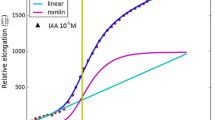Abstract
A sigmoid curve with three fitting parameters is proposed as a descriptive model for the spatial velocity field in one-dimensional growth of plant organs. Analytic expressions are derived for the relative elemental growth (REG) rate, the position and value of the REG rate maximum, the length of the growth zone, the inverse of the growth trajectory and cell length in the “elongation only” zone. The expressions are fit to published data to characterize the effects of environmental variation on growth of monocotyledonous roots. The simple expressions for growth may prove useful in mechanistic models. The fitted curves summarize more than a decade of observations and thus provide a challenge to theorists.
Similar content being viewed by others
Literature
Barlow, P. W., P. Brain, P. and J. S. Parker. 1991. Cellular growth in roots of a gibberellin-deficient mutant of tomato (Lycopersicon esculentum Mill.) and its wild-type.J. Exp. Bot. 42, 339–351.
Bertalanffy, L. von. 1960. Principles and theory of growth. InFundamental Aspects of Normal and Malignant Growth, W. W. Nowinski (Ed.), New York: Elsevier.
Buff, E. M., M. Baake, and A. Sievers. 1987. An empirical function for the description of root growth.Plant Physiol. 83, 685–690.
Erickson, R. O. and K. B. Sax. 1956. Elemental growth rate of the primary root ofZea mays.Proc. Am. Phil. Soc. 100, 487–498.
Esau, K. 1965.Plant Anatomy. New York: John Wiley.
France, J. and J. H. Thornley. 1984.Mathematical Models in Agriculture. London: Butterworth.
Gandar, P. W. 1980. The analysis of growth and cell production in root apices.Bot. Gaz. 141, 131–138.
Gandar, P. W. 1983. Growth in root apices. I. The kinematic description of growth.Bot. Gaz. 144, 1–10.
Gandar, P. W. and A. J. Hall. 1988. Estimating position-time relationships in steady-state, one-dimensional growth zones.Planta 175, 121–129.
Goodwin, R. H. and C. J. Avers. 1956. Studies on roots. III. An analysis of root growth in Phleum pratense using photomicrographic records.Am. J. Bot. 43, 479–487.
Gray, L. H. and M. E. Scholes. 1951. The effect of ionizing radiations on the broad bean root. Part VIII growth rate studies and histological analyses.Brit. J. Radiol. 24, 82–92.
Green, P. B. 1976. Growth and cell pattern formation on an axis. Critique of concepts, terminology and modes of study.Bot. Gaz. 137, 187–202.
Hejnowicz, Z. 1984. Trajectories of principal directions of growth, natural coordinate system in growing plant organ.Acta Soc. Bot. Polon. 53, 29–42.
Hsiao, T. C., W. K. Silk and J. Jing. 1985. Leaf growth and water deficits. InControl of Leaf Growth, N. R. Baker, W. J. Davies and C. K. Ong (Eds), pp. 239–266, Soc. Exp. Biol. Sem., 27, Cambridge, U.K.: Cambridge University Press.
Morris, A. 1990. The Richards Function as a Model for Axial Growth. Master's Thesis, University of California, Davis.
Pahlavanian, A. and W. K. Silk. 1988. Effect of temperature on spatial and temporal aspects of growth in the primary maize root.Plant Physiol. 87, 529–532.
Richards, F. J. 1959. A flexible growth function for empirical use.J. Exp. Bot. 29, 290–300.
Richards, O. W. and A. J. Kavanagh. 1943. The analysis of the relative growth gradients and changing form of growing organisms: Illustrated by the tobacco leaf.Am. Nat. 77, 385–399.
Rogers, D. F. and J. A. Adams. 1976.Mathematical Elements for Computer Graphics. New York: McGraw-Hill.
Savageau, M. A. 1980. Growth equations: A general equation and a survey of special cases.Math. Biosci. 48, 267–278.
Sharp, R. E., W. K. Silk and T. C. Hsiao. 1988. Growth of the maize primary root at low water potentials. I. Spatial distribution of expansive growth.Plant Physiol. 87, 50–57.
Silk, W. K. 1989. Growth rate patterns which maintain a helical tissue tube.J. Theor. Biol. 138, 311–327.
Silk, W. K., E. M. Lord and K. J. Eckard. 1989. Growth patterns inferred from anatomical records.Plant Physiol. 90, 708–713.
Silk, W. K. and R. O. Erickson. 1979. Kinematics of plant growth.J. Theor. Biol. 76, 481–501.
Silk, W. K. and R. O. Erickson. 1978. Kinematics of hypocotyl curvature.Am. J. Bot. 65, 310–319.
Silk, W. K. and S. A. Haidar. 1986. Growth of the stem ofPharbitis nil: analysis of longitudinal and radial components.Physiol. Veg. 24, 109–116.
Taiz, L. 1984. Plant cell expansion: regulation of cell wall mechanical properties.Ann. Rev. Plant Physiol. 35, 585–657.
Verhulst, P. F. 1838. Notice sur la quoi que la population suit dans son acroissement.Corr. Math. Phys. 10, 113–121.
Author information
Authors and Affiliations
Rights and permissions
About this article
Cite this article
Morris, A.K., Silk, W.K. Use of a flexible logistic function to describe axial growth of plants. Bltn Mathcal Biology 54, 1069–1081 (1992). https://doi.org/10.1007/BF02460667
Issue Date:
DOI: https://doi.org/10.1007/BF02460667




